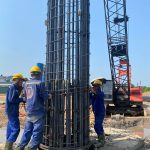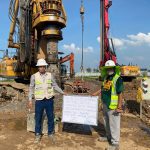The development of pile making techniques has continuously produced new types of piles, which has opened up a wide area for the design of pile foundations for high-rise buildings, allowing designers to choose different types of piles. Piles have better technical features and higher economic benefits.
Some design issues of pile foundations of high-rise buildings
1. Principles of pile selection
(1) Geological conditions
This is often the first factor to consider, and is also a relatively complex issue. The general rule is 2 things:
First: The type of pile selected must be economical, most effective in specific geological conditions, consistent with the requirements of the structure above (bearing and settlement), that is, advanced;

Second: The selected pile type can be constructed in those geological and environmental conditions, that is, feasibility.
For example: When the bedrock or solid gravel layer is not too deep, first consider the support pile. To maximize the bearing potential at the pile head (bearing layer), you must choose a pile with a diameter large, high strength, reliable in quality (especially with pile and column foundations), can clean the bottom of the hole, and attach to the rock.
If the construction load is not very large or not concentrated (the column distance is relatively small), it is also possible to take advantage of the sedimentary layer as a load-bearing layer, thereby choosing a pile with a smaller diameter.
When the original lava is located very deep (for example, over 100m), only friction piles can be considered, but it is necessary to make sure that the pile is well supported on a load-bearing layer with sufficient features and thickness (a dense sand layer just below the surface). or solid clay), to ensure that high-rise buildings do not sink too much.
At that time, there are many types of piles to choose from. The soil layer that can serve as the load-bearing layer for the pile foundation is not just one. When choosing the type of pile, you must pay attention to the following issues:
When the pile must penetrate a sandy soil layer with a fairly large thickness, it is necessary to judge the penetration ability of the driven pile or the effectiveness of wall retention when making deep holes, and must consider the construction capacity of bored piles or the ability to penetrate. and the strength of the driven pile body; If the good bearing layer has enough thickness but is not too deep (medium compact sand layer or hard plastic clay), you can consider using short piles or bottom expansion piles.
(2) Structural characteristics
The structural form, column steps on the ground floor (wide space), the relationship between high and low floors, along with the stiffness and load of high-rise buildings must be considered very carefully when choosing the type of pile.
For example, Dong Phong Automobile Tower in Shenzhen, the main house has one underground floor, 17 floors above ground, frame structure - shear wall made of reinforced concrete poured in place, three-storey enclosure with concrete frame structure Reinforced concrete poured in place. There are no settlement joints or expansion joints between the main house and the house.
Seeing that the height and load of these two parts of the house are clearly different, and the geological conditions are relatively good, two different types of piles were selected respectively:
Under the frame columns and walls of the main house, the shear force is concentrated, so large diameter bored piles were chosen to withstand the concentrated load (f1400mm and f2200mm), the pile tip is 800mm embedded in the slightly weathered original lava layer, meeting the requirements for resistance. force and subsidence of the main house; As for the fin house with light load, use a cheap submerged pile (f480mm) to form the foundation of a group of small piles under the column. Although it is a friction pile, the tip of the pile is in a layer of sand and gravel mixed with clay below. There are no weak floors, so settlement is very small.
Such treatment ensures that the settlement difference between high houses and low houses is very small. Practice has proven that the pile type chosen for this project is economical and reasonable.
(3) Construction techniques and environmental conditions
Any type of pile requires the use of specialized mechanical construction equipment and a certain construction technology process to be able to perform.
Therefore, under the determined geological and environmental conditions, the type of pile selected needs to be considered whether it takes advantage of existing equipment and technical capabilities to achieve the diameter and depth goals. No, on the other hand, whether the environmental conditions of the site allow that construction technology to proceed smoothly or not, these issues must be carefully calculated, otherwise the type of pile chosen will not be possible. can be made into reality and is also not reasonable.
For example, in the Shanghai area with precast reinforced concrete piles over 50m long, because the resistance when lowering the pile into the ground is very large, the impact force of the hammer must be increased, which will lead to the tensile stress when hitting the hammer exceeding the intensity. of concrete, it is mandatory to use prestressed piles, otherwise it is necessary to change to another type of pile.
Another example: around the construction site, if it is near a street or other construction project, there are many interwoven pipes under the road surface, so the impact of the pile will be large, causing many impacts. Regarding soil insertion and noise, this is usually not allowed. You can only use filters that do not insert soil, do not cause vibrations, and have low noise.
(4) Technical and economic efficiency
The final choice of pile type must also analyze the comprehensive technical and economic justification for the design option. If we only look at the pile's bearing capacity or the cost of a pile, we ignore the overall economic benefits of the whole project, or we only consider the speed of construction and ignore the environmental impact and social benefits. It's impossible to choose a really reasonable type of stake.
2. Regarding structure and calculation of piles/pile foundations
Here, only the specific issues of piles and pile foundations in high-rise buildings are mentioned, but the general issues are according to the provisions of the corresponding pile design and construction standards.
(1) Pile arrangement
In normal cases, the distance of soil-filled piles (when making piles, the soil is pressed tightly) is 3-4d (d is the pile diameter), unfilled piles are 2-3d, bottom-open piles are 1, 5 – 2 D (D is the bottom opening diameter). When applying piles and soil together to bear the force, there must be another argument.
The pile arrangement must be such that the center of gravity of the pile group matches the point of impact of the combined force of the load. As for the form of pile arrangement, under the columns are mostly symmetrical polygons, under the walls are rows of piles; Under rafts or boxes, try to arrange them along the center line of the column grid, rib beam or partition wall.
(2) Precast reinforced concrete piles
a) Place pile body steel
a1) Steel density: Hammer-driven piles should not be less than 0.8%, pressed piles should not be less than 0.5%, pressed piles with small and long pile bodies should not be less than 0.8%.
In the following cases, the steel density must be increased to 1%-2%:
– The pile tip must penetrate a certain thickness of solid soil;
– L/D diameter ratio of the pile is greater than 60;
– Piles are arranged thickly over a large distance
When L/D is greater than or equal to 80, the bearing capacity of a single pile is very large but the number of piles under the platform is very small or there is only 1 pile, then the steel density must be increased.
a2) Diameter and number of bars
The longitudinal reinforcement diameter should not be less than 14mm. When the pile width or diameter is greater than 350mm, the number of bars should not be less than 8.
a3) In the following cases, additional steel should be placed
– When using 1-2 piles and single rows of piles, if there is an eccentric load, additional steel must be placed at the top of the pile body.
– When the pile body only places steel according to the pile crane stress, additional steel must be placed in the crane hook area.
b) Concrete pile body
The concrete strength of the pile body is not lower than C30. The thickness of the longitudinal reinforcement protection layer is not less than 30mm.
c) Pile joints
The number of pile connectors should not exceed two. When in the shallow layer there exists a difficult soil layer
If the penetration is over 3m thick, the connector must be located underneath that layer of soil.
Glue joints can be used in cases where it is expected that the pile will easily penetrate the soil.
When the design load is large, small and long piles must penetrate hard soil layers of a certain thickness; In earthquake zones or places with many piles, welding methods must be used.
3. Filled piles
Types of bored piles: The commonly used type of bored pile has a diameter of D = 600 ~ 1500mm, a depth of 35 - 60m or more.
Structural requirements of bored piles
High-rise buildings can use drilled bored piles, drilled bored piles to create holes, casing bored piles to create holes and bored piles to dig holes. Diameter, length, distance, concrete strength... of bored piles must conform to the following requirements:
a. The diameter and length of bored piles must usually match the requirements of the construction load and ground conditions;
b. The distance of bored piles is about 2.5 - 3.5d;
c. The concrete strength of the pile body is not lower than C15.
When pouring concrete under water, it must not be lower than C20.
d. The concrete strength level when used to make concrete pipes to hold the wall and dig holes by labor must not be lower than C15. When calculating the bearing capacity of a single pile, regardless of the effect of the concrete pipe holding the wall, only take The inner diameter d is the calculated diameter of the pile.
e. Steel placement of concrete-filled pile bodies must be determined by calculation and must comply with the following requirements:
– Steel placement density in axial compression piles should not be less than (0.2 ~ 0.4)%, longitudinal reinforcement diameter should not be less than 10mm, longitudinal reinforcement in supporting piles must be placed throughout the length of the body. piles and must be arranged evenly along the pile circumference.
– The pile is affected by horizontal force, the internal force of the pile body can be calculated using the "m" method, the length of the longitudinal reinforcement is 4.0/a. When the pile length is less than 4.0/a, it must be placed throughout the pile length. Where a is the deformation coefficient of the pile body, the longitudinal reinforcement placement rate of the pile should not be less than (0.4 ~ 0.65)%.
– Anti-pull piles must be based on calculations to place tensile steel piles along the entire length or part of the length of the pile body, longitudinal reinforcement must be arranged evenly along the pile circumference. The welded connector of the longitudinal reinforcement must necessarily comply with the requirements of the tensile connector.
– The stirrup diameter can be from 6 ~ 10mm, the distance can be 200 ~ 300mm, it is recommended to use spiral or circular stirrups. If the pile is subjected to horizontal force, the stirrup at the top of the pile must be adequately thick. When the length of longitudinal reinforcement is over 4m, a line of reinforced welded reinforcement should be placed every 2m.
– The concrete layer protecting the longitudinal reinforcement must be no less than 30mm thick. When pouring concrete underwater, the concrete layer protecting the reinforcement must be no less than 50mm.
4. Pile foundation
(1) Radio structure
The base of a single pile foundation, raft foundation, interference beam foundation and the bottom slab of a box foundation must have a connection structure with the pile according to the following requirements:
a. Basic dimensions of the radio:
– The distance from the center of the boundary column to the edge of the station should not be less than the diameter of the column, the diameter or average side length of the pile, the distance from the pile to the edge of the station should not be less than 150mm.
– The width of the bottom plate of a two-row pile cap or a single-row pile cap should not be less than 2 times the diameter or length of the pile edge, nor should it be less than 600mm, the distance from the edge of the pile to the edge of the pile should not be less than 150mm .
– The thickness of the pile foundation must be determined based on the requirements of the structure above
This thickness from the surface of the cushion layer must not be less than 300mm. When the cup is tapered, the thickness of
The edge of the platform must not be less than 300mm.
b. Requirements for concrete and steel installation:
Concrete strength level must not be lower than C15; The diameter of longitudinal reinforcement in the beam should not be less than 12mm, the diameter of vertical reinforcement should not be less than 10mm, and the diameter of stirrups should not be less than 8mm.
The station is in the form of a slab, so the bearing reinforcement should be used with a relatively small diameter, but not less than 10mm, the distance should not be greater than 200mm, nor should it be less than 100mm. The bearing reinforcement on the bottom of the station should be placed directly on top. pile head surface after the pile head has been flattened according to the design level.
c. Requirements for connecting piles to the station or to the bottom slab of the box foundation:
The length of the pile head embedded in the base or bottom plate of the box foundation should not be less than 50mm. The length of longitudinal reinforcement of the pile pulled into the station or into the bottom slab of the box foundation is taken according to the anchorage length when subjected to tension.
d. Thickness of the concrete layer protecting the station reinforcement:
The thickness of the concrete layer to protect the steel reinforcement is not less than 50mm. When there is a concrete buffer layer, the layer protecting the reinforcement below can be reduced to 30mm.
(2) Location of the pull beam of the pile cap
a. The pile cap must be made of beams pulling in two directions perpendicular to each other. The double pile cap must be made of beams pulling in the short direction of the pole.
b. The bottom surface of the radio pulley beam should be the same as the bottom surface of the radio. The height of the traction beam must be determined by calculation and must not be less than 1/15 of the center distance between adjacent stations, the width should not be less than 200mm.
The smallest cross-section of longitudinal tensile reinforcement of a tensile beam can be determined by taking 1/10 of the maximum axial force of the column to which it is connected as the tensile force, but must not be smaller than the top and bottom of each side. 2 bars 14mm diameter. The stirrup diameter should not be less than 8mm, the distance should not be greater than 300mm.
c. It is possible to use foundation beams supporting reinforced concrete walls or foundation traction beams when there is an earthquake-proof design to make traction beams for the station.
d. When designing tensile beams, it is necessary to take into account the effects of bending moments and eccentric moments caused by errors in pile positions during construction.
(3) The problem of calculating the shear resistance of the bottom slab of raft and box pile foundations
Current processes, regulations and some related design documents talk about structural requirements and calculations of puncture resistance, shear resistance and straight section strength...
In particular, the digital document has introduced in relative detail the calculation of puncture and scissoring of the bottom plate of raft piles and box piles under the impact of vertical load.
It should be emphasized that when the bending moment M at the top of the pile is very large and the bottom plate is not thick enough, the moment causing shear stress at the bottom plate can be very large, after adding the shear stress due to the vertical force N. Moreover, checking its intensity must be given special importance.
Associate Professor. Dr. Nguyen Ba Ke
(Source: T/C Nguoi Construction, No. 1/2006)
Contact Info:
- Address: No. 12, Street 27, Van Phuc Urban Area, Hiep Binh Phuoc Ward, Thu Duc City, HCMC
- Phone number: 0915.611.337 Mr. Phuong Or 0915.411.337 Mr. Quan
- Email: [email protected] or [email protected]
- Website: Lethycorp.com
- Road Map: See





